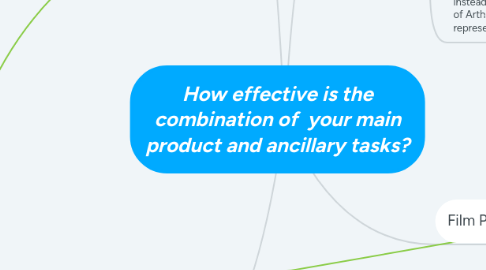
1. Article & Graphic Design
1.1. For our article we directly mimicked and copied the style as it is done it the magazine "Little White Lies". We replicated not only their visual aesthetic but also their style of writing, having read various other LWL articles in preparation for writing our own. This was done to get a genuine feel of what our film would look and read like as done professionally in the magazine. The graphic design however was not so easily mimicked, as the magazine itself has many different artists all with their own styles, so instead we began to create our own style, whilst still sticking in the vague guidelines of it being a 'graphic design'. The overall look of the design creates a strong imagery of the gritty London life, something we strongly convey in the film and wanted to mirror here also. The light patches throughout the image represent the light and hope in Arthur's life, sadly visually clouded away by the darkness and hatred that also literally overcloud him - in the form of the 3 boys that torment him. Little White Lies chose to have a graphic design next to their articles as they want the creators to have visual freedom in creating an image that represents the deeper emotions within their films - as opposed to a film poster which might conform to what 'the audience want' rather than what they want to show themselves.
2. How They Interlink
2.1. Although all 3 have many aspects that do not relate to each other - which in a way is good because we have been able to capture the many different aspects of our original concept, idea and intent towards the audience - they do all have similarities and connections which make them a stronger package than 3 stand alone tasks.
2.1.1. Firstly, all 3 have godlike symbols that are contradicted with the darkness within them - in the film there is an entire scene inside a church in which Arthur has his solitary moment of hope that has been building up since the beginning of the film, this is then cross cut with shots of his belongings burning which straight away shows the contrast and contradictions within that scene. In the poster the focal point is the religious statue of Mary which is straightaway contrasted visually with the black surrounding it, showing that the strength and power of the statue is only surrounded by darkness. Finally the graphic design has elements of light and hope within the light white spots dotted around Arthur's head, created there to give off the feel of heaven and hope, but is once again visually and metaphorically clouded with darkness.
2.1.2. Secondly we have given a great deal of through composition wise throughout the creation of all three products. We wanted to never have Arthur completely in the middle of all of his shots so as not to give him power in the scene, as we wanted to represent his weakness and him almost being at the point of admitting defeat, however he gains strength at one point in the church scene where we have a shot of him walk down the aisle in the centre, however this is slowly broken down again by the events that follow this. Likewise in the graphic design we have placed him off centre, which immediately creates an unbalanced feel to the image, letting the audience subtly know that everything is not right and that they should expect something bad to come. However, in the poster we wanted to give superiority and power to the image of Mary, which only makes Arthur smaller and less able to have any power himself at all. We thought that having complete symmetry would add to the high impact the image already has on the viewer.
2.1.3. Thirdly, when thinking about and focussing on colour in these products, we wanted to concentrate on predominantly dark, dim, blue and green tones - to fit the mood of the film and of Arthur. In our graphic design we thought that having strong colours would detract from the image we wanted to put across, so in this although there are definitely some cold colours within the image, the main colour is grey (which clearly represents the mood of the film straight away and foreshadows Arthur's character and his journey). In the film, apart from one scene (the church scene, which we have chosen to colour grade to warmer tones, to create a stronger impact for this scene), every scene in the film somehow has a blue or grey tinge to it, whether that be subtly (for example the scenes in the coffee shop that show a contrast from Arthur's life to those around him) or strongly (for example in the scene in which Arthur sleeps inside a tube station, as this strongly conveys the weakness and sadness of his character. Additionally in our film poster the main colours are blue and black, as this is the colour the Virgin Mary wore. This straightaway gives the poster a cold feel to it but yet subtly has an additional tint of warmth and hope within the orange, warm toned colours of the candle.
